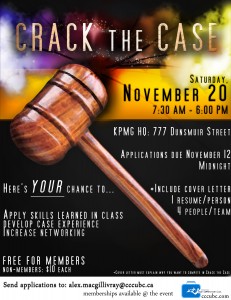On Saturday, I had the pleasure of attending Case Competition Club’s “Crack the Case” Competition, as creative marketing director, hosted by KPMG.
There were around 18 teams that applied, and only 7 accepted into the competition. Originally, I had planned on applying for the competition, but I’m glad that I got to do timekeeping instead.
Timekeeping sounds like such a simple task, and it was, essentially. However, what was great about the role was only that it was simple, but also that I could watch the entire presentation and judging process. That being said, I took down a lot of notes on what the judges looked for, and what they looked for in a presentation.
General format of the competition: 4 hours prep, 10 minute practice, 15 minute presentation, 10 minute Q&A, 5 minute judge review.
Judge’s specific criteria (based upon memory): PowerPoint, content, presentation skills, recommendations, and Q&A.
While these are general guidelines to the presentation, the judging really didn’t come down to the marks chosen based on the criteria. Analysis had to be concise; recommendations required back-up evidence; implementations had to be realistic in terms of manpower, cost, and time.
Finally, one of the most important aspects of the case was the presentation. I took down some notes after each presentation and judge’s debrief and compiled it to the information below:

CONTENT
- DO have some sort of chart (i.e. flow) outlining your problems & solutions
- DO have an implementation plan/timeline (Gantt Chart). It’s good to keep track of where you are in the presentation (timeline indicator)
- DO limit on analysis, don’t just regurgitate all the facts. The judges have read the case.
- DO cover the necessary materials, but do not speed through slides
- Do NOT deface the company in any way (i.e. I like XX instead of yours)
- DO present as if you were talking to a board of directors; you’re convincing them to “hire” you

POSTURE
- Do NOT stick hands in your pockets, cross them over your chest, or clench them into fists.
- DO make use of the space and move around
- DO spread out members across the room
- Don’t make hand movements too drastic or keep them too minimal (generally keep between shoulders and stomach)
SPEECH
- If you have a heavy accent, SPEAK SLOWER! There were many participants who had accents but were great presenters.
- If you don’t have an accent, still make sure to pace yourselves. Words can be lost when you speed through (less is more)
- Address the “company”, not the “case”
- Be engaging in your speech. Be convinced of your own words, or no one else will be convinced of them either. A charismatic speaker can be the defining point between winning presentations. Don’t sound staged or rehearsed either, because that automatically makes the speaker not as convincing
- Spread parts out equally
- Avoid these words: cuz, like, um, right, obviously, you, you know, I think, the case, kinda, wanna, gonna, um, you guys.*
*To put this into perspective, I made tallies on the last two groups of the times they said a particular word. A few fibs are okay, but there is a definite boundary to what is acceptable and what is just purely distracting and superfluous.
| You know | like | Um/uh | Wanna/gonna | Kind of/kinda | You guys |
| 9 | 1 | 13 | 3 | 2 | 1 |
| 4 | / | 6 | / | / | / |
| / | / | / | 3 | 1 | / |
| / | / | / | 1 | / | 1 |
| 13 | 1 | 19 | 7 | 3 | 2 |
| You know | like | Um/uh | Wanna/gonna | Kind of/kinda | You guys |
| / | / | 12 | / | / | / |
| / | / | 20 | / | / | / |
| / | / | 27 | / | / | / |
| / | 8 | 30 | / | / | / |
| / | 8 | 89 | / | / | / |

One reply on “Crack the Case: A Review on Presentations”
Great post! I like how you focused on real presentation habits, especially slowing down and cutting filler words. Simple but really useful advice!